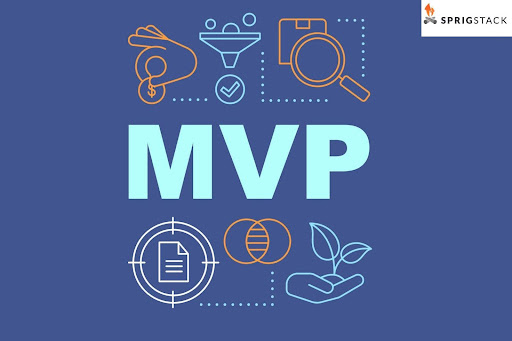Startups have to constantly come up with new ideas, change with the times, and fight with big companies in their fields in this fast-paced digital era. One idea that has changed the business world is the idea of fast iteration with a Minimum Viable Product. The Minimum Viable Product represents reducing your fundamental concept into basic essentials required to address central problems. The release of an MVP allows startups to obtain user feedback that helps them develop their products and adapt their direction rapidly. The objectives of new businesses become achievable faster through a partnership with a custom web development company.
These companies know how to make agile solutions that are flexible and easy to scale up or down. Startups reduce the time it takes to get their products to market by using fast expansion methods. They also make sure that the product they’re making really speaks to the people they want to buy it. Rapid development also helps businesses stay ahead of the competition by letting them try out new features and tactics without spending much money at the start. Overall, making changes quickly to an MVP is an excellent way for companies to be successful in the long run.
Understanding the MVP Concept
You can put out the basic form of a product, called an MVP, and sell it. It has just the right amount of features to please early users and prove that a company idea is viable. With this method, startups can try their ideas with little money and get information about how users behave, what they like, and what hurts them.
Rapid iteration means making, trying, and improving a product very quickly. Startups can make small changes based on real-time input by iterating quickly. This method lowers the chance of spending money on features users don’t want and speeds up the learning process for making new products.
Benefits of Rapid Iteration for Startups
Rapid revision helps businesses grow by letting them make changes and learn quickly.
Speed to Market:
The shorter time to market is one of the best things about fast revision. Startups can beat their rivals and get a piece of the early market by putting out an MVP quickly. This quick method is critical in tech-based fields where customers’ needs change quickly.
Cost Efficiency:
Making a full-featured product from the start can be expensive and dangerous. An MVP helps reduce costs by directing resources to the most essential features. As feedback is gathered, more money is spent based on what users have actually said they need, not what people think they want.
Enhanced User Feedback:
Rapid iteration allows user comments to be at the center of product creation. Startups eliminate the need for prediction by observing user behavior to optimize their products through implemented observations. Such particular attention to users results in improved products, which enhance customer loyalty.
Key Steps in Building an MVP with Rapid Iteration
For rapid development, each step in the MVP path is crucial.
Define Your Core Value Proposition:
Make sure you know exactly what problem your product will solve before you start making it. Figure out what features are necessary to solve this problem successfully.
Develop a Prototype:
Make a simple version of your product that shows what the main idea is. Based on user input, the prototype should be easy to understand, work, and change.
Launch and Gather Feedback:
Testing your Minimum Viable Product requires giving it to a few early users after completing development. Inquire about their honest opinions regarding product usability, functional performance, and user satisfaction.
Analyze and Iterate:
Review your collected data and find the most critical places to improve. Use this information to improve your product by adding or removing features and improving the experience of using it. This iterative loop should keep going until the result is what the market wants.
Scale Gradually:
Add more features and improve over time as your product changes and starts to live up to users’ standards. This careful growth keeps the product in line with what customers want and what the market is doing.
The Role of User Feedback in MVP Development
User feedback is the most critical part of constantly improving a product.
Embracing Constructive Criticism:
During the MVP process, user feedback is constructive. This not only shows what works, but it also shows what might go wrong. Startups can make smart choices about product changes and future developments if they are open to helpful feedback.
Continuous Improvement:
The circle of fast iteration is all about getting better all the time. Your MVP should get better with each iteration, fixing problems users are having and making the product’s main point stronger. The result of this iterative process is a strong product with a better chance of doing well in the market.
Technology and Tools for Rapid Iteration
The revision process is easier and faster when you use current tools.
Agile Development Methodologies:
Using agile methods can make the development process go much more quickly. For quick MVP development, agile systems must encourage teamwork, flexibility, and adaptable planning. Teams can keep track of their work and make quick changes with the help of tools like Scrum or Kanban boards.
Prototyping Tools:
Modifiable mockups appear automatically with the help of contemporary prototyping applications such as Sketch, Figma, and InVision. Developers can observe their conceptualizations through these tools before receiving speedily delivered feedback to modify ideas while avoiding lengthy programming duties.
Analytics and Monitoring:
MVP usability requires data tracking tools to understand people’s behavior when using the product. Using Google Analytics with Mixpanel and Hotjar will show how people utilize your platform. They help teams find ways to improve things and see what effect small changes have.
Conclusion
With an MVP plan, startups can quickly iterate on their goods, get them on the market, improve their core offerings, and lower the risks that could cost them a lot of money. Using advanced development tools, agile methods, and getting real-time feedback from users are all essential parts of this ongoing process. Startups that use rapid iteration make goods that better meet customer wants while also cutting down on waste and development costs.
By offering specialized technical knowledge and scalable solutions, working with a custom web development company speeds up the process even more. Adopting this flexible method leads to new ideas and happy customers and sets the stage for long-term success in the market.






